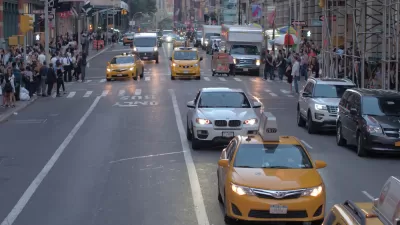NHTSA's announcement that automatic emergency braking will become standard on almost all new vehicles by 2022 will have dramatic safety implications for drivers and passengers, but will it prevent crashes with pedestrians and cyclists?
Traffic fatality statistics have shown a disturbing trend over the last decade for non-motorized transportation. Thanks to better construction making vehicles more crashworthy, combined with the use of seat belts and air bags, total traffic fatalities and injuries have declined* while pedestrian fatalities have been increasing.
"2015 saw a 10 percent increase in pedestrians killed in motor vehicle crashes compared to a four percent decline in overall traffic deaths during the same period," notes a March 9 post on the Governors Highway Safety Association report based on preliminary data on traffic fatalities last year.
The joint announcement on March 17 by the U.S. Department of Transportation’s National Highway Traffic Safety Administration (NHTSA) and the Insurance Institute for Highway Safety (IIHS) of a "commitment (to) make AEB (automatic emergency braking) standard on virtually all light-duty cars and trucks with a gross vehicle weight of 8,500 lbs. or less beginning no later than Sept. 1, 2022" is great news for traffic safety advocates. But will this crash avoidance technology benefit those outside of vehicles?
This video shows what the technology is capable of doing—preventing or moderating rear-end crashes. Pedestrians and cyclists may or may not be covered depending on the rating of this life-saving technology.
To encourage further development of AEB technology, NHTSA will accelerate its research on more advanced AEB applications, including systems that reduce the risk of collisions with pedestrians. In December, NHTSA announced plans to rate AEB systems and other advanced technologies under its 5-Star Safety Ratings beginning in model year 2018.
According to that December 2015 announcement, pedestrians could see benefits from the new technology:
- A new 5-Star Safety Ratings system, which will, for the first time, encompass assessment of crash-avoidance and advanced technologies as well as pedestrian protection;
- New tests to assess how well vehicles protect pedestrians from head, leg and pelvic injuries that occur when a pedestrian is struck by a vehicle...
Bill Chappell of NPR further describes the safety benefits resulting from "20 carmakers have committed to making automatic emergency braking systems a standard feature on virtually all new cars sold in the U.S. by 2022."
*Traffic fatalities increased last year by eight percent to 38,300 according to the National Safety Council.

Montreal Mall to Become 6,000 Housing Units
Place Versailles will be transformed into a mixed-use complex over the next 25 years.

Planetizen Federal Action Tracker
A weekly monitor of how Trump’s orders and actions are impacting planners and planning in America.

DARTSpace Platform Streamlines Dallas TOD Application Process
The Dallas transit agency hopes a shorter permitting timeline will boost transit-oriented development around rail stations.

Study: 4% of Truckers Lack a Valid Commercial License
Over 56% of inspected trucks had other violations.

Chicago Judge Orders Thousands of Accessible Ped Signals
Only 3% of the city's crossing signals are currently accessible to blind pedestrians.

Philadelphia Swaps Car Lanes for Bikeways in Unanimous Vote
The project will transform one of the handful of streets responsible for 80% of the city’s major crashes.
Urban Design for Planners 1: Software Tools
This six-course series explores essential urban design concepts using open source software and equips planners with the tools they need to participate fully in the urban design process.
Planning for Universal Design
Learn the tools for implementing Universal Design in planning regulations.
City of Mt Shasta
City of Camden Redevelopment Agency
City of Astoria
Transportation Research & Education Center (TREC) at Portland State University
US High Speed Rail Association
City of Camden Redevelopment Agency
Municipality of Princeton (NJ)




























